Talena Winters's Blog, page 2
September 4, 2025
The Power of Perseverance
You know what’s not sexy? This. But do it anyway.

“Perseverance is the hard work you do after you get tired of doing the hard work you already did.”— Newt Gingrich
Ah, September. The leaves outside my window are turning the colours of flames. For those of us affected by the school calendar (and living in North America), September (or somewhere around there) is a season of change.
For me, autumn always feels like a time of refocusing. Perhaps it’s the return to routine that causes the mental shift.
Whether you or your children have returned to school in the last month or not, we’re now at the three-quarters mark of the year. Have you re-assessed your yearly goals lately? How about your lifetime goals? When was the last time you thought about those?
I don’t know about you, but I think about mine a lot. When I’m in a season of refocusing, I attack the steps to get there with gusto and energy.
But when the steps you’ve been doing don’t seem to be producing the desired results, it is easy to get discouraged, and focus can melt into floundering. It makes me want to skip to the end, read the last page, and just finish this story already! Like Princess Fiona in Shrek: The Musical, I want to “Skip ahead! Skip ahead!”
Let’s take a look at some lessons from some of our favourite characters (fictional or not) to survive those floundering seasons, shall we?
 Perseverance—The Most Admired Character Trait
Perseverance—The Most Admired Character TraitWhen I googled perseverance quotes for this post, I was nearly overwhelmed by the number of excellent soundbites of sage wisdom that came up. And as I thought about it, I realized that in every story that gets told, every character we admire, the common thread is the character trait of perseverance.
At least for the “happy” endings. For the other ones, chances are they gave up eventually.
(Even one of my least-favourite literary stories, The Road, has a sad—not tragic—ending where the character persevered—he achieved his goal, in a sense, by choosing to retain his humanity in the face of a culture that seemed determined to strip it away from him. I think he did it in a stupid way, which is why I dislike the ending, but he did it, and that, at least, is admirable. I don’t want to spoil it for those who might want to read/watch it. Other people love it, so you might, too.)
Let’s face it, we probably consume and create far more stories where the main character didn’t give up than ones where they did.
“In other words, without perseverance, they would never have achieved their goal.”
Why? No matter what other character traits that person had, if they didn’t persevere, they wouldn’t have had a story worth telling.
In other words, without perseverance, they would never have achieved their goal.
Napoleon Hill is famous for saying “What the mind of man can conceive and believe, it can achieve,” which is often now paraphrased as “If you can believe it, you can achieve it.”
While this is true on a simplistic level (yes, you can achieve anything that’s physically possible for you to achieve), it’s missing that key element required to go from belief to achievement: work.
Fortunately, Mr. Hill also talks about patience, persistence, and perseverance quite a bit in his work. However, I remember being a young artist with big dreams and a perspective tinted rosy by the “believe it-slash-achieve it” mantra and being frustrated that the results I wanted were taking so long to come.
It’s important to remember that between those two points of the journey (believing and achieving), there’s a whole lot of road that can have its exciting moments, but is often hard work or just plain boring. But each step still takes you closer to your goal.
One of my favourite movies of the last several years is Eddie the Eagle, the true story of an Englishman who did what he’d been repeatedly told was physically impossible for him to do: ski in the Olympic games.
It tells the story of Michael Edwards, a man who, from childhood, dreamed of being in the Olympics.
He had very little going for him as far as talent or circumstances, and a great deal against him.
His father continually got in his way and told him he was dumb for wanting this.
His peers actively blocked him.
He didn’t really have the physical ability to excel in his field.
Yet, through a little ingenuity and a whole lot of determination (including the willingness to take a physical beating over and over again), in 1988, he represented Great Britain in ski jumping at the Winter Olympic Games in Calgary, Alberta.
His stubborn determination to persevere was practically his only asset. And it paid off.
 Perseverance. It’s the secret ingredient.
Perseverance. It’s the secret ingredient.I could list story after story of perseverance, as I’m sure you could, too. That’s because almost every story, no matter how epic or suspenseful or sweet or romantic, has a character that gave it one more shot. No matter how many times they got knocked down, they got up again.
Can you imagine Jean-Claude Van Damme having a career if, at the end of every movie, when he’s been beaten to a bloody pulp, his character just stayed down? Of course not.
Let’s take that lesson and make it ours.
You might be in a season of focus and energy, and if you are, great.
Or you might be floundering, wondering why you haven’t achieved more or had more success by now.
Chances are, you’re going to continue to cycle through those two places. What do you do about them while you’re there?
Take those seasons of floundering as times to adjust course.Perseverance is necessary, but being stupid isn’t. If you’re hitting a brick wall, get creative and try something else. But keep trying.
Use the inertia of seasons of focus, excitement, and energy to propel future success.Write down your successes so you can remember them, learn from them, and mostly so you can be inspired and remember that they will return when you are floundering. We humans have an incredible “gift” for forgetting the positive things in our life, so record them for posterity.
But no matter where you are, keep going.You can only drive a car that's moving.
You only become a hero if you keep getting up after you get knocked down.
And you only succeed if you keep putting in the daily, unsexy work required to get to your goal.
It’s through that daily drudgery and, yes, even the floundering, that we become who we need to be to finish our stories.
There’s no skipping ahead. We have to keep taking our lives one page day at a time, just like everyone else.
That’s how we get true satisfaction when we finally get where we want to go—in a story well lived.
“The artist is nothing without the gift, but the gift is nothing without work.”— Emile Zola
This post was originally published in the Books & Inspiration Newsletter on 2019-09-12. Like what you read? Get regular inspiration in your inbox by signing up here.
New song release:
Now available as early access for Books & Tea League members: Christian rock worship song “Help Me Find the Words”.
Get early access and show your support for the price of a cup of coffee.
Releases publicly on September 10.
Listen NowThanks for reading!
August 14, 2025
Creating Space to Grow: My Summer Reset and What’s Next
For the past month, I’ve been taking a break from creating content. I was determined to enjoy summer, and I have been.
We had company (including all three boys—the first time they were home simultaneously since Christmas!), went on a quick road trip, and visited with friends. I picked berries and tended my flowers and went on walks. And I rebuilt and relaunched my knitting design business, My Secret Wish Knitting, on a more affordable, lower-pressure tech stack—because why not? (A change is as good as a rest though, right? 😜)
Honestly, this wasn’t a typical “summer break” for us, though. While I won’t get into details here, my husband was home from work for a month during a period when I wasn’t intending to take a break at all. However, I desperately needed one, so I rearranged my production schedule and decided to “take it easy,” even if I didn’t take a full break.
Because of how close to burnout I was feeling, and the burnout my husband was actually experiencing, over the course of that month, it became clear to me that I need to make some shifts in my business. I need more white space, but I also need to take on more of the household financial responsibility much sooner than my established business trajectory would allow.
In other words, I need to create more margin in my business and our family finances, fast. And that’s why I’m making some pivots in my business, starting immediately.
Don’t worry—from your side, the pivots will seem small, and may even improve your experience. But for me and my family, they could be significant.

My sweet Daisy chilling in the shade on the deck after a splash in the dugout.
Phase One: Create SpaceThe first stage of my plan (mostly complete) was automating a great deal of the mind-numbing tasks required to run my business. I’ve actually been implementing this for the past several months, slowly streamlining processes on the back end to cut down on admin time while providing the same or better service to my audience.
This week, I finalized some automations for my newsletter and content notifications that will allow me to keep in better contact with you, dear reader, all while freeing up several hours a week.
For you, this means:
My newsletter subscribers will receive my blog and bonus content posts by email the day after they’re posted—no more waiting a week or two to explore that new bonus perk, read that short story, or listen to my latest track.
My biweekly newsletter will now serve as a digest of recent content (in case you missed any of the individual posts) while continuing to include a quick personal note to my readers and promoting discovery of other great authors through swaps and promos.
Earlier in the summer, I automated eBook and audiobook delivery from Bookfunnel when someone purchases a book from my store, replacing my previously clunky process. Now, digital books will be automatically sent to purchasers by email.
Automations for the win!
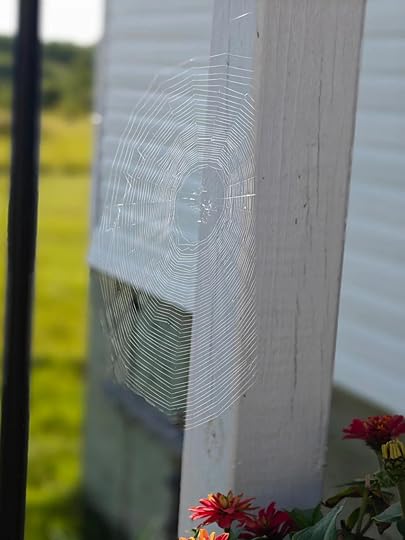
Some amazing well-built architecture with a great view for the creator.
Phase Two: Scale and GrowYouTube & ClassesYouTubeNow that I’ve regained some leeway in my week, I’m planning to spend those newly gained hours growing my Youtube channels—with a primary focus on my somewhat-neglected Author Alchemist / Word Wizard Academy editing and author development brand.
I’ve been training my son Noah to edit video so I can subcontract work to him, which means I’ll only need to do the content planning and creation part.
If you’re a writer (or you want to be) and you’re interested in learning ways to improve your craft and business savvy as an author, make sure you’re on my Word Wizard Academy mailing list to be notified about new posts.
For my author and songwriter brand channel, I’ll continue to create music videos of my tracks as I complete them, but I’ll soon be posting my audiobooks to the channel, too.
ClassesFor some time, I’ve meant to start teaching classes about writing craft and marketing online. I simply haven’t gotten organized to do it.
But now, I am.
I’ll be teaching a class about brainstorming or fixing stories with a single sentence (the log line) in mid-September. For details about that when I announce them, join my Word Wizard Academy list.
For you, this means:
More great content, more affordably.
Getting direct access to my secrets to level up your writing craft (for authors)
And by simply consuming that content, you’ll help me get to my monetization goals faster, too.
KickstarterI’m going to keep trucking on my special edition Kickstarter for Finding Heaven. One of the things I did during my “take it easy time” was to continue proof-listening to the audiobook. When I’m finally finished with that (maybe sometime next week?), I’ll be setting up my Kickstarter campaign. Watch this space for more details.
For you, this means:
Getting some of your favourite stories in new formats (audiobooks, special editions)
Brand and Freelance ServicesMy rather untraditional “day job” is working as a freelancer. For the past eight years or so, I’ve focused on working with editing clients. I love doing this, in that I find it very satisfying to level up both stories and authors and watch them reach their full potential. However, as I’ve learned about my ADHD brain, I’ve realized why shorter-term, quick-win projects are always so much more appealing to work on.
So, to work with my brain instead of against it, I’ve decided to pivot my freelance work slightly toward more copywriting, brand messaging, and marketing projects—something I’ve done for years, but haven’t made a focus.*
If you’re a creator, author, entrepreneur, professional, or small business looking up to level up your brand messaging or get help with your website copy or email marketing, please check out the copywriting services I offer to see if we’d be a good fit.
*I’ll still take editing clients, I’m just going to promote my other services more. (I also still write and polish book descriptions, which I adore doing.)
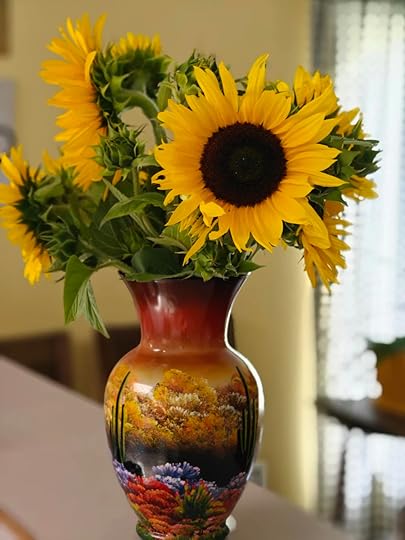
These stunning beauties were a birthday gift from my neighbours and friends, J and B.
Setting a New CourseA rolling stone gathers no moss, so they say. In this rapidly changing world, and with we, ourselves, always changing, being nimble is an asset.
This life change has made me step back and rethink what my highest priorities are right now. I think these small shifts will not only lead to better financial stability for our family, but also steer me toward a course I’ll find much more sustainable for the next several years—or until the wind changes again.
But if not? There’ll be another chapter after that.
How about you, my friend? How are you handling these uncertain times? Have you had to make any life changes to adapt? Let me know in the comments!
July 21, 2025
The Making of Finding Heaven
This post was originally a newsletter I sent out in 2016 as I was writing Finding Heaven. As I prepare to release the audiobook, I thought I’d re-share the process behind writing this book.

Several years ago, one of my writing mentors [the now-late Holly Lisle] was talking about how what you write needs to be something that is true to who you are, what makes you tick.
I nodded my head. It made perfect sense to me, because I knew that I want to write stories that matter.
She talked about one of her peers who, despite having great success in her field, absolutely hates what she writes.
This made me wonder, Why would somebody write books they hate? And how could they be successful at it?
As I started to explore these ideas, I began to become acquainted with Sarah Daniels, the star of my new book Finding Heaven.
I realized that Sarah (who was known as “Jessica Hufnagel” at the time—don't ask :-D) might have been sexually abused, and became an erotica writer. So I started researching.
It didn’t take me long to realize that this is going to be an important book.
So important, I didn’t think that I was going to be ready to write it for at least another couple of years—and I wondered if I ever would be. This isn’t exactly fluffy stuff, after all.
Then, last year [now a decade ago in 2025], my little boy was tragically killed. And for some reason, the historical fantasy book series I had been planning (hint: mermaids. Shocked?) didn't seem like the right book for me to write right then. I mean, all writing is therapeutic, but the kind of therapy I needed was way more “real” than mermaids. (Not saying mermaids aren't real! But mermaids don’t make good grief therapists.)
When I told my husband about my new book, he asked, “Why are you writing about that? Will anyone want to read it?”
I was pretty sure they would.
Grief, no matter the cause, is so very universal. The grief of Childhood Sexual Abuse might be different in cause than child loss, but the trauma and the anger from all that is lost because of it must still be addressed.
When I knew that it was time to write Sarah’s story, I plunged into the depths of learning about her, what her life is like, and trying to figure out what she might do about it. And while I was learning about how survivors of abuse can find healing, I was walking my journey of healing, too.
All the stuff I learned helped me start sorting out some other junk in my personal closet. (Hey, I got baggage, you got baggage—there's just a whole lotta baggage goin’ on.) So when my husband (NOT my target audience, by the way) asked if anyone would want to read my book, I shrugged. But then I figured that if writing this book is helping me to heal, then reading it will help others to heal, too.
If it matters to me, it will matter to my readers.
Will it help someone? Will it give someone hope? Will it at least entertain them?
If the answer to any of these questions is yes, then I have succeeded.
As it turns out, my instincts about this book were right. It has touched so many lives, and received rave reviews. I’m excited to finally be bringing an audiobook version into the world (via my upcoming Kickstarter—join my newsletter to be notified when it launches) so even more people can discover it.
Here’s some of the feedback this book has received:
“★★★★★— Shellee Devore on Goodreads
What an amazing heartfelt book. I couldn’t put it down. What an inspiration to us all...
Amazing. I highly recommended this book.”
Go to Shellee’s review on Goodreads.
“★★★★★— Teresa Lockwood on Goodreads
Beautiful story. This story is very inspiring and honest to real life. Loved this story and will look for more by this author!”
Go to Teresa’s review on Goodreads.
Recent Bonus Content:
Recent bonus post for members: “The Music of Finding Heaven”, a curated playlist soundtrack for the gripping emotional page-turner. Requires a free Books and Tea League account to access.
Get Finding Heaven:Would you rather get the book now in print or eBook? Good news—you can!
Head over to this page to learn more and purchase.
The current print covers will be going away after my Kickstarter, so grab those now if you like them! (You can read more about the cover changes of Finding Heaven in this post.)
Happy reading!

The current print cover for Finding Heaven. Clicking on the image takes you to the print book purchase page.
July 15, 2025
Summer Growth: Songwriting, Streamlining, and the Finding Heaven Kickstarter
’Tis the season for gardening and being outdoors and filling the creative well. For guests and reading on the deck. For going places and slowing down.
But I’ve still been working behind the scenes. (As per usual.)

Any season is napping season for Aang.
New MusicAs mentioned in this post, I came back to my songwriting roots in a big way a few months ago. (Before I started publishing fiction, I aspired to be a career songwriter. I went to college as a piano and composition major and everything.) Since the passion rekindled, I’ve mostly been composing as a “hobby” during my evenings and weekends.
Right now, I’m not sure where I am with that long-dormant dream of professional songwriting, but learning how to produce and release my music has been bringing me immense amounts of joy.
I’ve been releasing new tracks early to premium members of the Books and Tea League. But if you’re not a premium member, never fear—several of my new tracks are now publicly available.
Now Public:
“In the Valley (Psalm 23)” - an uplifting worship song about finding light in the darkness.
“The Way You Love Me” - A feel-good Christian pop song.
“God of the Desert and the Storm” - An alternative Christian pop rock song about focusing on God during difficult times.
New song (early access for premium BATL members):
“Beautiful Mystery” - a pop rock ballad about the mystery of grace


I also have several older, previously released tracks. (And more in the pipeline!) You can see what’s currently available in my Listening Room blog.
Finding Heaven Kickstarter progress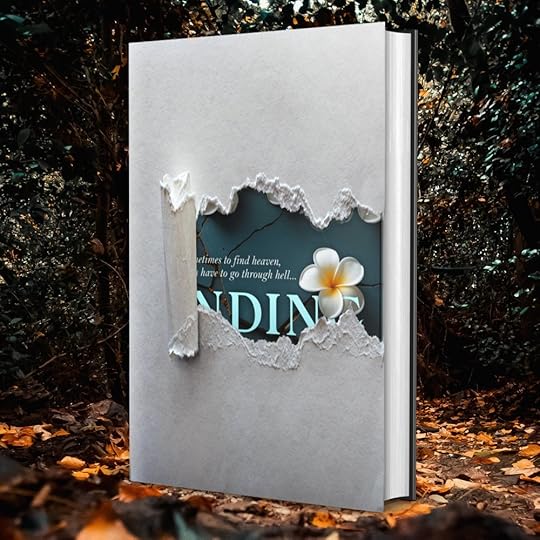
In May, I announced my intentions to launch a special edition of Finding Heaven on Kickstarter. I’m not going to lie—this is a daunting project. (Kind of like everything about this book has ever been, so what else did I expect?)
Right now:
I've still got about ten chapters of the digitally narrated audiobook to finish proof-listening to.
Last week, I composed an original song that will be part of the special edition Kickstarter release. It’s the first completely from-scratch song I’ve written in several years (since producer, author, and publisher Jim Jackson chose “Dark Side” to promote his Prairie Witch horror anthology), and it may be one of the best songs I’ve ever written. That's all I'll say for now. (Except that almost every time I play through this song, I start to cry. I can't wait for you to hear it.)
Once I'm finished proofing the audiobook, I'll be pricing out the special edition hardcover, choosing a printer, ordering proofs, and setting up the Kickstarter campaign.
Hopefully, I'll have more news by the end of the month.
Nurturing Growth
Some wild violets I found growing in my field this spring. Thanks to Anne Shirley (Anne of Green Gables), I have an extremely romanticized affection for wild violets.
My “word of the year” for 2025 is life-giving. In the first half of the year, I’ve implemented a lot of changes to the foundational structures of my business (including shutting down my knitting pattern design brand). Behind the scenes, I’ve been simplifying my content creation process (a project I’m finally nearing the end of… for now). The intention was to streamline and automate as much of the backend admin and marketing work as I can so it can become less labour-intensive and more life-giving for me—and allow me to produce more work to bless, encourage, and entertain you.
I’m hoping in the second half of the year, you’ll start to see the fruits of those changes. I should have more time to focus on creative projects, especially fiction.
But despite the efforts I’ve been making behind the scenes to align with my year’s guiding ideal, a good chunk of achieving a life that’s more “life-giving” is simply learning to take some of the pressure off of myself. It’s not easy for me to do, but, as summer sets in in earnest, I’m going to try.
And I hope you can do the same, my friend.
June 30, 2025
14 Clean YA Fantasy Reads for Teens and Adults by Canadian Authors
Looking for your next clean YA fantasy read? In honour of Canada Day, I’ve rounded up a list of talented Canadian authors writing fantasy books for teens that are imaginative, clean, and highly rated by readers. Whether you’re into dreamwalking vigilantes, magical boarding schools, or ancient secrets buried in jungle temples, this list has something for every kind of adventurer.
All of these authors are either Canadian or currently live in Canada, and most are indie or small press. These stories are wildly different in tone and setting, but each one delivers magic, heart, and high-stakes adventure. I haven’t personally read them all, but I made sure each one has received glowing reviews on Amazon or Goodreads—so you can read with confidence.
And yes—I included my own series too. 😉
This post contains affiliate links. That means if you click through and make a qualifying purchase, I’ll make a few cents at no extra cost to you.
 Clean Young Adult Fantasy Fiction by Canadians1. Talena Winters – Rise of the Grigori Series
Clean Young Adult Fantasy Fiction by Canadians1. Talena Winters – Rise of the Grigori Series 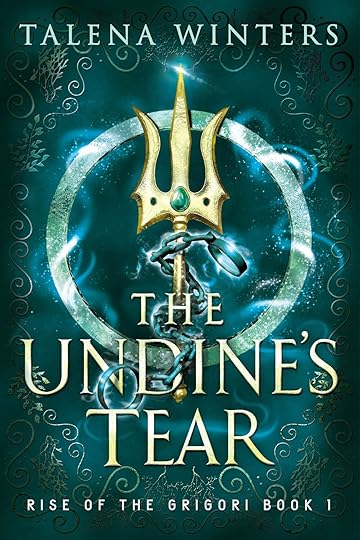
Genre: YA Clean Epic Historical Mermaid Fantasy
Read the series: Rise of the Grigori
Mermaids. Magic. And a mistake that could end the world. Three thousand years ago, a Mad undine sank Atlantis—and now their society is unraveling. As the most powerful healer in millennia, Calandra must face impossible choices to redeem her people and stop an ancient evil from unleashing chaos. Lushly built, emotionally resonant, and grounded in faith and hope, The Undine’s Tear kicks off an epic mermaid fantasy like no other.
2. Grace R. Pringle – Silver Blood
Genre: YA Dragon Fantasy
Author Website: gracepringle.com
Book Link: Read the book
A curse. A deal. Death. In a fractured kingdom under siege, three teens find their lives forever changed by betrayal, dark magic, and a deadly dragon-borne illness. With themes of friendship, sacrifice, and the cost of survival, Silver Blood is a gritty, character-driven tale from a rising Canadian fantasy author. Perfect for readers who like their dragons fierce and their stakes sky-high.
3. Suzy Vadori – The Fountain Series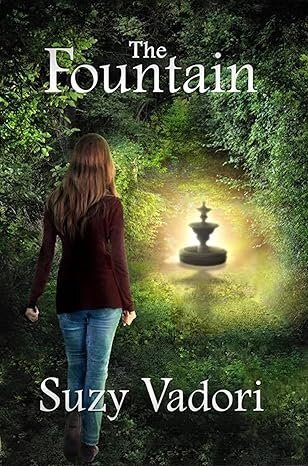
Genre: YA Contemporary Academy Fantasy
Author Website: suzyvadori.com
Book Link: Start the series
Careful what you wish for—it just might come true. Ava Marshall transfers to St. Augustus to uncover the truth about her mother’s past, but a hostile classmate and an ancient school rivalry threaten to ruin everything. When she discovers a magical fountain in the forbidden West Woods, Ava makes a wish that changes her fate. But magic always comes at a cost... The Fountain is a charming mix of mystery, romance, and boarding school drama with a twist of magic.
4. Amanda Wright – Darkfell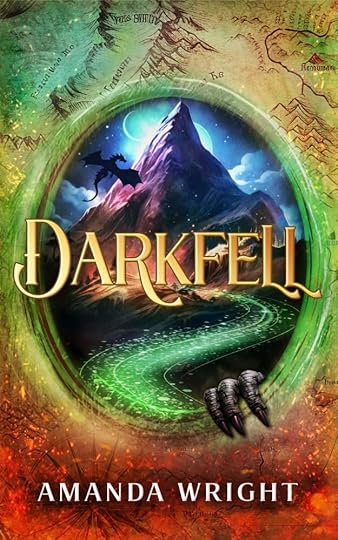
Genre: YA Christian Fantasy
Author Website: awrightauthor.ca
Book Link: Read the book
His is a life of books and peace… until a dying warrior’s touch ignites an ancient magic in his blood.
Thom Darkfell is a cartographer, not a hero. But when he’s conscripted into war and witnesses the impossible, a hidden power awakens within him. Visions. Prophecies. A call to find the star-born girl who can seal the barrier between realms. With only a cryptic map and a few brave companions, Thom must face the rising darkness—or see his world fall. Darkfell is a powerful Christian fantasy full of rich lore, heart, and high-stakes adventure.

Genre: YA Epic Fantasy
Author Website: jaewaller.wordpress.com
Book Link: Read the series
A rebellious Indigenous heroine faces a colonial world coming unstitched in this richly imagined debut. Seventeen-year-old Kateiko has the power to shapeshift and control water—but in a world on the brink of civil war, she must choose between love, loyalty, and survival. With its layered mythology, LGBTQ+ and BIPOC representation, and dual-world narrative, Call of the Rift is a must-read for fans of immersive, character-driven YA fantasy.
6. L.R. Knight – Rise of Shadow, Reign of Light Trilogy
Genre: Clean Epic Fantasy
Author Website: lrknight.ca
Book Link: Read the series
Darkness rises as ancient evil threatens the Kingdom of Light. In a war-torn world, Kaldon must confront his hidden identity and choose whether to embrace his destiny. With cinematic battles, rich lore, and clean storytelling, this Alberta author’s epic fantasy is perfect for fans of high-stakes quests and courageous heroes.
7. Douglas Smith – The Dream Rider Saga Trilogy
Genre: YA Urban Fantasy / Superhero Adventure
Author Website: smithwriter.com
Book Link: Read the trilogy
Indiana Jones meets Teen Titans in this fast-paced, award-winning saga. Will Dreycott, a reclusive teen with the power to walk in dreams, teams up with two other gifted teens to hunt for his missing parents and fight evil across dreamscapes and ancient ruins. Winner of the Aurora Award and filled with action, mystery, and heart.
8. Jessica Renwick – Starfell Series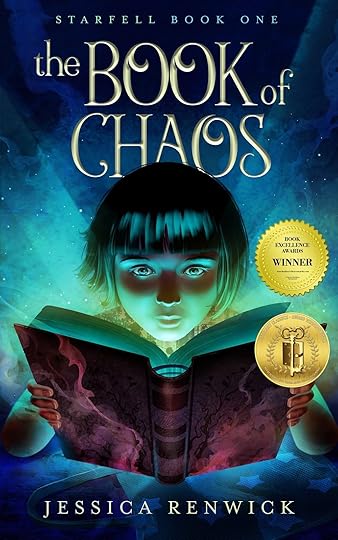
Genre: Middle Grade Second-World Fantasy
Author Website: jessicarenwickauthor.com
Book Link: Start the series
Twelve-year-old Fable discovers a magical world—and her own hidden power—when her cousin disappears into a mysterious book. With talking animals, mystical creatures, and heartfelt friendships, The Book of Chaos is a charming, award-winning adventure that’s ideal for younger readers and fantasy lovers of all ages.
9. Adam Dreece – The Yellow Hoods Series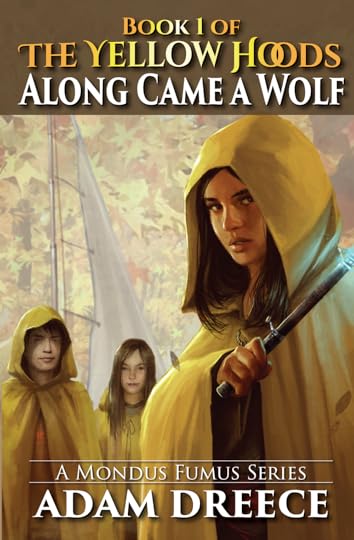
Genre: MG & Early YA Steampunk Fantasy
Author Website: adamdreece.com
Book Link: Start the series
Steampunk meets fairytale in this imaginative and humorous adventure. When Tee and her friends stumble upon a secret plot involving steam tech, secret societies, and nursery rhyme legends, they must rise to become unlikely heroes. Think clever gadgets, heart, and a touch of whimsy—perfect for fans of inventive fantasy.
10. Elizabeth Whitton – Houses of the Old Blood duology
Genre: YA Urban Fantasy
Author Website: elizabethwhitton.com
Book Link: Read the book
A past that haunts her. A boy who finds her. A secret hidden in her blood...
Addie Stevens just wants to fly under the radar—but when shadowy creatures attack, she discovers a hidden world of ancient dynasties, blood magic, and her own mysterious heritage. Hunted and forced to flee, Addie must embrace the truth of her lineage before it destroys her family. Winner of the 2018 Aurora Award for Best YA Novel, Houses of the Old Blood is an action-packed, emotionally rich urban fantasy perfect for fans of dark secrets and magical legacies.
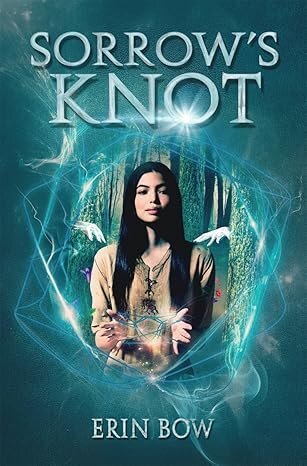
Genre: YA Dark Fantasy
Author Website: erinbow.com
Book Link: Read the book
In the haunting forests of the Shadowed People, Otter is destined to bind the dead—until something goes terribly wrong. Winner of the Monica Hughes Award, this lyrical and eerie fantasy explores death, friendship, and unraveling magic with unforgettable depth. A quiet masterpiece for fans of the mythic and strange.
12. Heather Fawcett – Even the Darkest Stars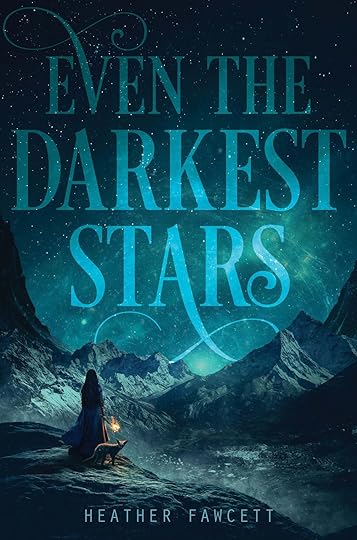
Genre: YA High Fantasy / Adventure
Author Website: heatherfawcett.com
Book Link: Read the book
A young explorer braves avalanches, ghosts, and deadly secrets on the Empire’s tallest peak in this atmospheric fantasy inspired by Everest expeditions. With breathtaking worldbuilding and a twisty plot, Even the Darkest Stars is perfect for readers who love strong heroines and mountain-climbing magic.
13. Liselle Sambury – A Mastery of Monsters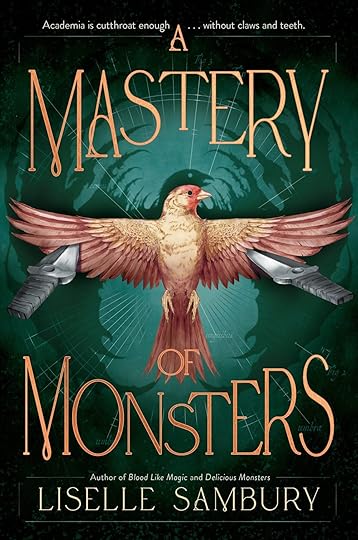
Genre: YA Dark Academia Fantasy
Author Website: lisellesambury.ca
Book Link: Read the book
Ninth House meets Legendborn in this blood-soaked, thought-provoking fantasy. August must infiltrate a secret society of monsters to find her missing brother—but doing so means facing disturbing truths and becoming something new. With razor-sharp prose and high emotional stakes, this upcoming release promises to be a breakout hit.
14. Kenneth Oppel – Airborn Trilogy
Genre: MG Steampunk Adventure
Author Website: kennethoppel.ca
Book Link: Read the series
Aboard a luxury airship, cabin boy Matt Cruse rescues a balloonist and uncovers a sky full of mystery, pirates, and mythical creatures. This Governor General’s Award–winning trilogy is full of sky-high thrills, steampunk innovation, and unforgettable heart—perfect for readers who love action-packed MG fantasy.
Final ThoughtsIf you’re a fan of clean YA fantasy books with strong female leads, magical worlds, or high-stakes adventures written by talented Canadian authors, this list should keep your TBR pile full all summer long.
Happy Canada Day—and happy reading! 🍁
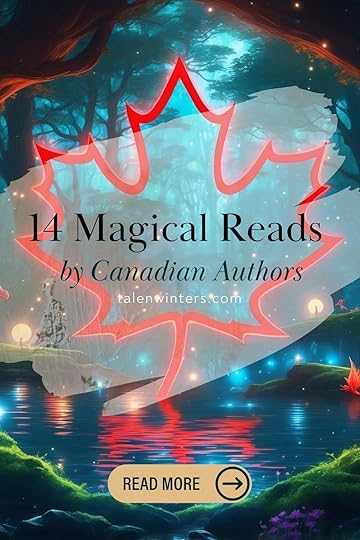
June 23, 2025
A New Look for Finding Heaven: Cover Reveal (and a Peek at Something Special)
Sometimes you write a book, and you get the cover right the first time.
Sometimes you write a book, and it takes you… seven tries.
(Yes. Seven. We’re at seven now.)
If you’ve been around for a while, you might remember that I shared a whole post last year about the evolving face of Finding Heaven—from its very first cover to several I designed but never used and the one it’s been wearing since 2020. (If you missed that post, you can find the full cover history on the Books and Tea League community blog right here—you’ll need a free membership to read it.)
Well, friend, here we are again. This story has grown, and it’s time for the cover to grow with it.
Why Change the Cover? (Again?)When I first released Finding Heaven eight years ago, I chose a cover that felt right at the time. But as I’ve continued learning, growing, and testing new designs, I realized that while the story inside was connecting deeply with the people who read it, the invitation—the cover—wasn’t always reaching the readers who would love it most.
It turns out, sometimes a story needs a new package. A new way to say, “Hey, this might be for you.”
So after a lot of thought, research, (and yes, a few click tests), I’ve found a new look for Finding Heaven that feels like home—a cover that better fits the emotional journey inside and speaks more clearly to fans of authors like Kristin Hannah, Nicholas Sparks, and Charles Martin.
Here’s the New Cover!Drumroll, please…

The new eBook cover for Finding Heaven.
This is the new face of Finding Heaven—at least for now.
It will be the cover for the eBook edition currently available in my store and on all major retailers. And based on the early response, it seems to be connecting beautifully with the right readers. (I’ve already seen a bump in interest, which tells me the story is finding new hearts.)
But Wait—There’s More!What you see here isn’t the only new cover this story is getting.
I’ve also been working on a special edition hardcover for a Kickstarter I’m planning to launch later this year, and that version will have its own unique cover—one that’s deeply tied to the story’s heart.
The design is inspired by the Japanese art of kintsugi—the practice of mending broken pottery with gold, creating something more beautiful for having been broken. This concept is woven into the story in a powerful way and holds personal meaning for me as well. (I shared more about that in a special post just for my Books and Tea League members.)
If you’re curious to see that cover now (and get the story behind it), you can unlock the exclusive reveal here. (Joining the Books and Tea League is free—it just takes a moment to sign up, and you’ll get access to other members-only goodies too!)

Click the image to be taken directly to the cover reveal post for the special edition.
What Happens Next?Right now, I’m still in the planning phase for the Kickstarter. I don’t have a pre-launch page to share with you yet, but I’ll be sure to keep you updated when it’s time.
In the meantime, if you’ve ever thought about picking up a paperback or hardcover copy with the current cover, now’s your chance. I’ll be retiring that version soon to make room for this new chapter in Finding Heaven’s life.
Thank you, friend, for walking this road with me—for being part of this book’s journey, whether you’ve read it already or it’s just now catching your eye. Stories evolve. Sometimes their covers do, too.
And sometimes, it takes seven of them to get it just right.
June 16, 2025
Become the Hero: How to Rewrite the Stories We Tell Ourselves
Big (Sneaky) Little Lies that Sabotage Us, and What We Can Do About Them.

“Be mindful of your self-talk. It’s a conversation with the universe.”— David James Lees
This post contains affiliate links. That means if you click through and make a qualifying purchase, I’ll get a few cents at no extra cost to you.
I’ve been thinking a lot lately about the lies we tell ourselves.
Normally, I tie in to a fiction book or three in these posts, but this time I’m going to talk about an idea that’s been in two non-fiction books I read a few years ago… and which is used in every fiction book, ever. I’m going to call this topic The Lie We Believe.
When I teach story structure, I explain that you must know the Lie your character believes before you begin writing, or you don’t know what your story is about. The Lie is what represents your character’s inner conflict. It’s what they must overcome before they achieve their goal. The Lie makes your character relatable.
Jamie (A Walk to Remember by Nicholas Sparks) believes her illness means she can’t have a future with love. Katniss (The Hunger Games by Suzanne Collins) believes she must always protect everyone else and can never let anyone protect her. In It’s A Wonderful Life, George Bailey believes that because he didn’t get to pursue his original dream, his life has no value. And Margaret (The Proposal) believes she must control everything and keep people at arm’s length to survive.
In my own stories, Sarah (Finding Heaven) believes she’s too damaged to be worth saving or to be worthy of happiness. Zale (Rise of the Grigori) believes he’s a monster who’s a danger to everyone he cares about. And Stephanie (Every Bell that Rings) believes Christmas can never be happy for her, since all her most terrible and traumatic moments are associated with the holiday.
There’s a reason writers must find the Lie our character believes that holds them back from becoming better. It’s because everyone does that.
Even you. And me.
Unfortunately, the Lie we believe can be hard to detect. It is usually impossible to uncover until life circumstances or another person makes it obvious to us.
Here are a few lies I’ve told myself:
I’ll only ever be mediocre at best. I can be good at something, but not truly great.
I’m a bad mom.
I’m a bad wife.
I’m damaged and no one will want to be with me.
I’m bad at public speaking.
People don’t really like me, they’re just being polite.
I’m not enough.
Sometimes I can recognize these as lies when they come up and am able to overcome them on my own, especially if it’s as simple as a mental self-chastening like “you know that’s not true, you’re hormonal, you’ll feel better in about three days.”
But some of those lies have been so ground in that it took years to recognize them as lies, let alone overcome. And sometimes the overcoming came with the help of people who loved me, therapy, and a healthy portion of divine grace.
And for some of them, I still have to make a conscious decision on a daily basis to counteract that lie with a different story—a story that is more true, or that I am choosing to make true.
Self-Fulfilling PropheciesHere’s the thing about the stories we tell ourselves—the more we repeat them, the more true they appear to be.
Someone who tells herself that no one likes her will behave in a way that no one likes and push people away to protect herself from the so-called inevitable hurt before it can happen.
Someone who believes that he will never achieve true greatness might be extremely driven and hard-working, but when it looks likely that he might achieve his goal, unconsciously sabotage his own success. (That was me.)
Someone who tells herself that it is scary to talk to people will have a fight-or-flight response whenever she is forced into a situation where she must be social.
That’s the bad news. But here’s the good news:
You can decide what story you tell yourself.
In 2019, I read two books that really opened my eyes to the ways we can be intentional with our own stories.
The first was 5 Critical Things for Successful Book Signings by Adam Dreece, in which he shares how he did exactly this when he decided to stop believing the lie that he couldn’t be an author because he has dyslexia and everyone always told him he couldn’t. (He’s done very well as an author, by the way.)
The second has a more general audience: The Alter Ego Effect by Todd Herman, who coaches stars, elite-level athletes, and high-powered executives to help them break through mental blocks that are preventing them from progressing in their careers.
Herman uses a technique in which he identifies the qualities within a client that are preventing them from achieving their goal, and helps them develop an “alter ego” that draws on qualities that are more suited to that particular task, or Field of Play—whether it’s on the court, in their role as a parent or friend, in their job, whatever.
This is not “fake it ’til you make it.” It is deliberately choosing to use aspects of yourself in the appropriate setting to achieve success in that area—something humans have been doing since the dawn of time. In fact, you probably already do this. You behave differently online than you do in person, right?
(An online friend I’d known for years expressed surprise when I mentioned how sarcastic I am in real life. I don’t put that online much, because the humour of sarcasm is usually lost in text, and I wouldn’t want anyone to think I was being in any way serious and be offended or hurt.)
You also behave differently with someone you just met than with someone you’ve known your whole life, right?
These are both “you”—they are just using the aspects of you that are most appropriate in that situation. (Or not. Maybe one of these areas is something you’d like to change about yourself. And you can!)
A few years ago, put this to the test when I presented at a writers conference. It was my second year presenting, and the previous year I had been shocked when the large rooms I’d been put in ended up being standing-room-only for my classes. I’m quite comfortable in front of rooms of, say, twelve people or less. But with over fifty (or maybe a hundred? It felt like a thousand) pairs of eyes staring at me, I completely lost my nerve—and it showed.
It occurred to me while reading Herman’s book that “I’m nervous speaking in front of large crowds” was only a story I had been telling myself, and I decided to test his technique by telling myself a different one. For the several weeks before the conference, whenever I would think about those crowded rooms and my palms would start to sweat, I’d take a deep breath and tell myself, “No, you’re not nervous speaking in front of large crowds, remember? You’ll be comfortable and at ease up there, just like you are when you speak to smaller groups. It will be fine.”
And you know what? It totally was.
The Power of Choosing Our StoryWe all have lies we tell ourselves. Usually, these can be sussed out by looking at areas in our lives where we seem to continually hit a wall or run into trouble or even disaster. “I’m no good at relationships.” “I can’t be a writer because…” “I could achieve this goal if only…”
First of all, you need to take responsibility for your own story and recognize the Lie. Stop making excuses. You will never overcome your Lie and change your story as long as you are letting it tell you who you are.
Then, you need to change your self-talk. Instead of “I can’t…” say “I’m still figuring out how…” Instead of “I don’t have time to…” say “I haven’t made this a priority yet.” Instead of “I’m no good at this,” say “I haven’t acquired that skill yet.”
Take those negative words and own your responsibility in them, then turn it around so you can’t tell yourself a lie with your self-talk every time it comes up.
Second, tell yourself a new story that counteracts the lie. Decide what qualities you need to use in a certain situation, and then imagine yourself using them. You will draw on those qualities when the time comes and probably surprise yourself with the person you never knew you could be.
If this is something you want to learn more about, I recommend picking up Todd Herman’s book. Obviously, he goes into this in much more detail and applies it to a wide range of situations that may help you.
Bottom line: Since the story you tell yourself becomes a self-fulfilling prophecy, be intentional with what that story is.
You just might find that the true hero of your story really is you.
(By the way, the Enneagram is the most useful tool I’ve found for revealing our Lies to ourselves so we can stop being controlled by them. If you’re new to the Enneagram concepts, I recommend either The Road Back to You by Ian Morgan Cron or The Honest Enneagram by Sarahjane Case as primers, and The Enneagram Guide to Waking Up: Find Your Path, Face Your Shadow, Discover Your True Self by Beatrice Chestnut and Uranio Paes as a deeper dive. But you can get started with an overview on this Enneagram Institute site page, which explains the basics. And the CP Enneagram website will help you find your type and subtype.
“You have brains in your head. You have feet in your shoes.— Dr. Seuss
You can steer yourself any direction you choose.
You’re on your own. And you know what you know.
And YOU are the one who’ll decide where to go...”
This post was originally published in the Books & Inspiration Newsletter on 2019-08-19. If you enjoyed it, please consider signing up. You’ll get Zale’s origin story (who I mentioned in the post) as a free gift when you do, plus a romantic women’s fiction novella.

Image courtesy of Dino Reichmuth via Unsplash.
June 10, 2025
Not There Yet: The Ten-Year Post I Didn’t Write

Last Tuesday was the ten-year anniversary of when my youngest son “graduated to heaven,” as my aunt called it in a bereavement text. I’d intended to write some deep, poignant, and inspirational essay about the joys I’ve found while healing along this grief journey since then, but honestly… I’m not in that place today. (There’s a reason this post is going up a day late.) And I wasn’t in that place last week, either. And who knows if I’ll ever be in that place?
A few months ago, I’d also had the idea to compile into a memoir and expand on the many essays I wrote about grief and loss and healing since Levi passed. But, again, I’m not in that place. I started on it, and it was very heavy work. (Not surprisingly.) Maybe in another five years. Or ten. Or maybe never. Who knows?
That’s the thing about grief that I can say—you never really know how it’s going to unfold for someone, and no two people are the same. And there’s really no rushing it.
So, instead, I'm going to continue with my plans to launch an audiobook and special edition hardcover for Finding Heaven through Kickstarter. This is the book I wrote as I grieved my loss, and it's also the first full-length book I published—the one that truly launched me into a career as a fiction author. Ten years after I began it (eight after releasing it), this book is still touching lives. And I'm very grateful.
I'm still in the early stages of planning the Kickstarter, but I'm working on figuring out the design for the special edition hardcover. Soon, I'll be "getting my hands dirty", so to speak, in figuring out the Kickstarter platform and setting up my campaign.
When it's ready to go live, you'll definitely be the first to know! (Get more details about the audiobook and Kickstarter in this post.)
In other news…Books:I’ve finally started drafting Every Rose that Blooms (Peace Country Romance Book 3), and when I’m feeling good about how the first few chapters are shaping up, I’ll start posting early access versions for Books and Tea League members to enjoy.
Music:I’ve been working through some concerns I had that impacted my music release strategy, and this past weekend, I gained some clarity about how I want to proceed with producing and releasing more songs.
I’ve also been working on setting up my artist platform. (I’m now an official artist on Spotify. If you use that platform, please give me a follow on my Spotify Artist Profile—and my Spotify Author Profile. You can also subscribe to my YouTube channel, which is where I'll be posting new tracks, music videos, and soon, audiobooks.)
And if this is the first you've heard that I’m publishing music, you can learn more and listen to some here. Or search your favourite streaming platform to find my latest tracks.
Here’s a video of one of my favourites that I’ve released so far:
That’s all for this week, friend. I’m all worn out from thinking about that post I didn’t write, so I’m going to go enjoy a walk and a cup of tea.
If you dropped by to read this, let me know in the comments. I’d love to hear from you, too. 💜
“The world is indeed full of peril, and in it there are many dark places; but still there is much that is fair, and though in all lands love is now mingled with grief, it grows perhaps the greater.”— J.R.R. Tolkien, The Fellowship of the Ring

June 2, 2025
Suspending Disbelief: How Writers Ruin Fictional Stories
When it comes to pushing the bounds of reality, how far is too far?
This post contains affiliate links. That means if you click through and make a qualifying purchase, I get a few cents at no extra cost to you.

“The more you can create that magic bubble—that suspension of disbelief—for a while, the better.”— Edward Norton
I have always consumed a wide variety of fiction, but my some of my favourite genres are fantasy and historical fiction. I especially love it when these two are mashed together, spilling into the urban fantasy or historical fantasy subgenres.
So, no surprise then that I ended up writing a historical mermaid fantasy series, I suppose…
However, not everyone loves this bending and twisting of the “real world.” While lovers of the genre are willing to suspend disbelief about fantastical elements (as long as the world follows consistent internal rules), there are others that slam a book shut the moment anything “unbelievable” happens. Some are so fixed in reality that they refuse to even read fiction.
“When we pick up a book, we’re entering into a contract with the writer that we will commit our time and money to the story. But if the writer violates that contract by mishandling the story, trust is lost, and the writer may have a difficult time regaining it.”
I’m not here to pass judgement on which is right or wrong. We are all different people, and our tastes are our own, and that’s okay.
(However, if you can’t understand the value in fantasy books for anyone, even if you’ve decided they’re not for you, I encourage you to read my post “Why the World Needs More Christian Fantasy”.)
Chances are, if you’re hanging out here, you don’t mind fiction, so I’m going to assume that on some level, you are willing to suspend disbelief when you read a story. Obviously, so am I. :-)
Today, I want to explore things that make even willing believers throw a book across the room. Where do you draw your line? How wrong does a writer have to be before you’ve had enough?
Here are the top three things that throw a wrench in my enjoyment of a novel—the “unforgiveable sins of writers” that make me say I can’t believe it.
Anachronisms that undermine historical accuracyLet me be clear: I’m totally fine with intentional anachronisms. I use a few of these myself in my stories, but with clear (at least to me) logic behind them. (E.g., in my Rise of the Grigori series, which is primarily set in 1799, the characters only ever use the word “okay” when not speaking English, as the word didn’t come into usage until around 1839. So it would be anachronistic in English, but when they are already speaking in translation—which they often are—I find it to be a useful inclusion to convey a more modern sensibility to my young adult fantasy readers.)
However, accidental anachronisms—ones the author included, likely out of ignorance and lack of fact-checking—are the proverbial burr under my saddle… sometimes. Actually, they have varying levels of effect on my enjoyment, depending on their role in the story.
For instance, I once read a historical romance wherein the writer used an anachronistic metaphor—an obscure one about a fact that many of her readers wouldn’t know, but which I did, because I’d just finished reading a book about that very topic! It bothered me a bit, but I was still able to enjoy the story for what it was because the writing and story were otherwise fantastic.
If it had been worse—say, if that metaphor had instead become a major plot point, but in all other ways the story implied it had been set in real-world history and the lone anachronism seemingly had no purpose, I would be bothered a lot more. I’d probably still read and enjoy the book, but my enjoyment might be diminished somewhat. (I’m pretty forgiving that way if the writing is good.)
However, if a story never purports to be historically accurate and purposely pulls in anachronistic elements to prove it? I’m all in. I actually enjoy them, if they are done well. (I’m looking at you, Tangled and Shrek.)
“If a story never purports to be historically accurate and purposely pulls in anachronistic elements to prove it? I’m all in.”
That being said, it still annoys me to see steel-boned corsets in Regency films and machine-sewn or synthetic clothing when they don’t belong. (What can I say? I’m a costume nerd.)
I’ve met readers who can’t stand anachronisms, even in alternate histories or historical fantasies. And I’m sure there are people who couldn’t care less about anachronisms at all, especially if the writing makes up for it in other ways. (For instance, the many, many fans of Dan Brown’s The Da Vinci Code. Okay, those were philosophical and religious misinterpretations, not anachronisms, but still…)
Where are you on the spectrum? Hard-boiled accuracy nut, anything-goes avid reader, or somewhere in between?
When the plot forces the character to behave unnaturallySometimes, writers write themselves into corners. They need something to happen in the plot, and they don’t know how to get there. Good writers will figure out a solution that they then go seed into previous parts of the story so they seem justified and believable. Bad writers—or writers of ongoing T. V. shows in a tight corner, apparently—just have a character do something that, to the audience, seems to come out of the blue.
When the show Heroes came out, I got sucked. in. My husband and I went through four seasons (which we even bought on disc!) so fast that our DVD player practically melted. Unfortunately, halfway through Season 3, one of the main characters made a decision that was so contrary to his nature and so poorly justified that, for the rest of the series, I enjoyed the show much, much less—especially his story arc. For the sake of the rest of it, I made the decision to accept the “new Nathan,” but I wasn’t happy about it.
At least this egregious writing error didn’t happen in the last two episodes of the show. (Sorry, Game of Thrones fans.)
What are some of your examples of this issue? Do you get completely turned off when a character acts out of character? Or are you able to forgive the writers and move on?
“That could’ve been solved in Chapter One…”It drives me crazy when a major plot point revolves around something that should have been solvable in about five minutes in the first three chapters OR which contradicts a rule of the world.
For instance, many of the problems and villains in the show (and, I imagine, the comic books) of The Flash should be solvable in milliseconds due to Barry Allen’s immense speed—and the writers often can’t come up with good enough obstacles to make this not true. Still, Barry somehow manages to let the villains gain ground or hurt people when, based on his previously demonstrated abilities, he should be able to resolve the entire issue in less time than it takes normal humans to blink. It’s like the writers throw up their hands and say, “It’ll have to do. We need to fill forty-two minutes, so he can’t solve this in the first five. That’s boring.” (And they’re right about that.)
“It drives me crazy when a major plot point revolves around something that should have been solvable in about five minutes in the first three chapters OR which contradicts a rule of the world.”
One of my writing colleagues recently posted that his editor had pointed out a plot hole in his draft big enough to drive a truck through—it turns out that a major plot problem in his story revolved around something the characters could have solved with a Google search. Doh! Back to the story board.
I had a similar plot problem in my first draft of The Undine’s Tear—a major plot point revolves around a mystery that seems to contradict the rules of magic in the world. The thing was, I hadn’t realized the problem I had created for myself until I was about halfway through writing the story, and while I came up with a solution and wrote it in from then on (and which actually made the ending more awesome), my beta readers mentioned the problem over and over again. By the time I addressed it in the story, it was too late—the trust was gone.
So I rewrote and fixed it by making it clear from the start that my characters knew this was something that shouldn’t have happened, but did. Because I let the reader know that the writer knows about the apparent contradiction, the reader can continue to read, trusting that I’ll explain it eventually. Which I do.
But what if I hadn’t? *shudder*
What about problems like this that actually make it to print? My sister detests the Harry Potter series (though she’s only read book 4, for some reason) because of the many plot problems and internal inconsistencies in the book. (She now detests it for other reasons, but those have nothing to do with the writing.)
I’ve met people who dislike Divergent because you have to suspend disbelief in so many areas. But obviously, not everyone feels this way or those stories wouldn’t have become the mega-blockbusters they are.
Where do you stand on this one? Do you have some forgiveness when the writer asks you to suspend disbelief over and over again? Or are you out of there at the first sign of trouble and on to watching reruns of Friends?
Since I enjoy both Harry Potter and Divergent, and since I still watched every season of The Flash (despite rolling my eyes at inconsistencies several times per episode), I guess I’m on the more forgiving side of the spectrum. I can honestly say I’ve never thrown a book across the room, and in fact, rarely stop reading one in the middle (unless it’s boring me to tears).
What each of these irritations boils down to is a breach of trust. When we pick up a book, we’re entering into a contract with the writer that we will commit our time and money to the story. But if the writer violates that contract by mishandling the story, whether out of laziness or ignorance, trust is lost, and the writer may have a difficult time regaining it.
This is the kind of thing that keeps “writer me” up at night. Thank goodness that I know that, for every person who is disappointed by how I held up my end of the bargain, there are dozens of others who finish my books completely satisfied. Those folks are my tribe.
Thank you for being part of it.
“I’m a great audience. I cry very easily. I suspend disbelief in two seconds.”— Stephen Sondheim (and me, haha)

The original version of this post was published in the Books & Inspiration Newsletter on 2019-06-13.
May 30, 2025
Finding Heaven Audiobook Update… and an Announcement

For the past several weeks, I’ve been working to complete the edits on the digitally narrated audiobook for my romantic women’s fiction Finding Heaven. For this project, I’ve been using ElevenLabs, who have some of the best AI voices available.
This has been quite the process—I originally started working on the audiobook in late 2023. Because it’s a long book and I have both time and budget constraints, I was planning to complete it bit by bit over six months or so, using one of ElevenLabs’ lower-tier plans to spread out the cost and time required. However, after completing the first eleven chapters (nearly 25% of the book), they discontinued the narrator I was using.
So, I started over and managed to complete the initial full-chapter outputs by last fall (and also worked in the audiobook for Every Bell that Rings while I was at it). However, I’m not the type to just publish whatever the AI spits out—there are always artifacts, mispronunciations, weird stresses, and other issues that need to be edited. As an audiobook listener myself, I really want my listeners to have a good experience.
Up until now, my workflow involved manually editing the corrected audio clips (or “punch-ins”) into the completed file in my audio editing software instead of re-rendering entire chapters (which used to cost credits). Before I finally got back to working on this project three weeks ago, I was already a little over halfway through creating the punch-ins, but I hadn’t done any of the final audio editing. Luckily, ElevenLabs had updated a few things in the several months I had been away (and it was to my advantage this time!), and now I can fix those poorly rendered bits and output an entire finished chapter without the onerous extra step of editing in the punch-ins, and at no extra cost to me. Yay!
I’m nearly finished fixing the second half of the book I’d had remaining, then I’ll need to go touch up the first half too (since the editing process is different now, and way easier than manually editing in those bits). And then this book will be done!
Which got me thinking... Since this story holds such a special place in my heart, and in the hearts of many of you, perhaps this launch deserves a bit of extra oomph. Like a new cover. Which would make a great special edition hardcover. And wouldn’t it be amazing to have a human-narrated version of this book?
And that means…
A Kickstarter for Finding HeavenYou read that right. I’m in the early stages of planning a Kickstarter for this book. The Kickstarter rewards will include:
The digitally narrated (and painstakingly human-edited) audiobook
A new special-edition hardcover with a gorgeous new cover and other special treatments (to be revealed soon)
Stretch goal of a human-narrated audiobook
What would you like to see? What kind of bookish swag or extras would light you up if I included them in this project? Let me know in the comments!
By the way, BATL Librarians and above can already listen to the (unedited) early access version of Finding Heaven’s digital audiobook. The first three chapters can be accessed publicly, if you want a preview.
Have you ever backed a book Kickstarter? If so, I’d love to hear what your favourite rewards were. This is my first project, and I want to make sure it’s full of awesome stuff! Hit up the comments section and tell me what you’d love to see in my Kickstarter!



